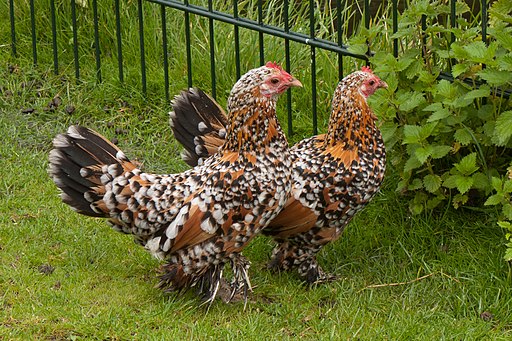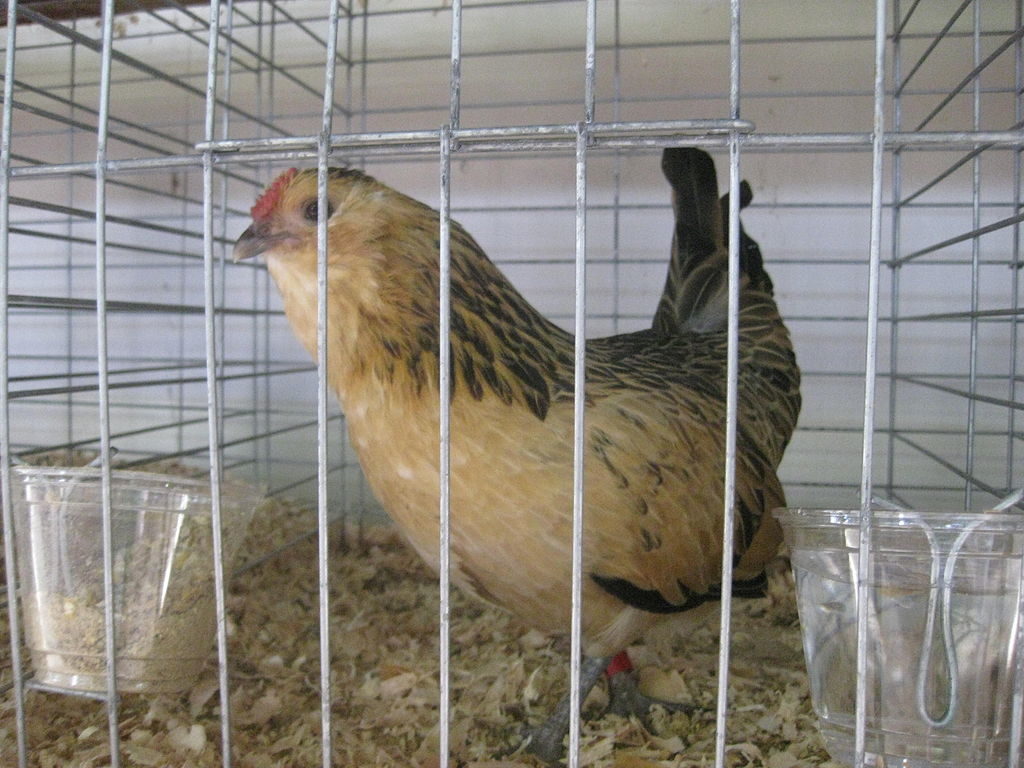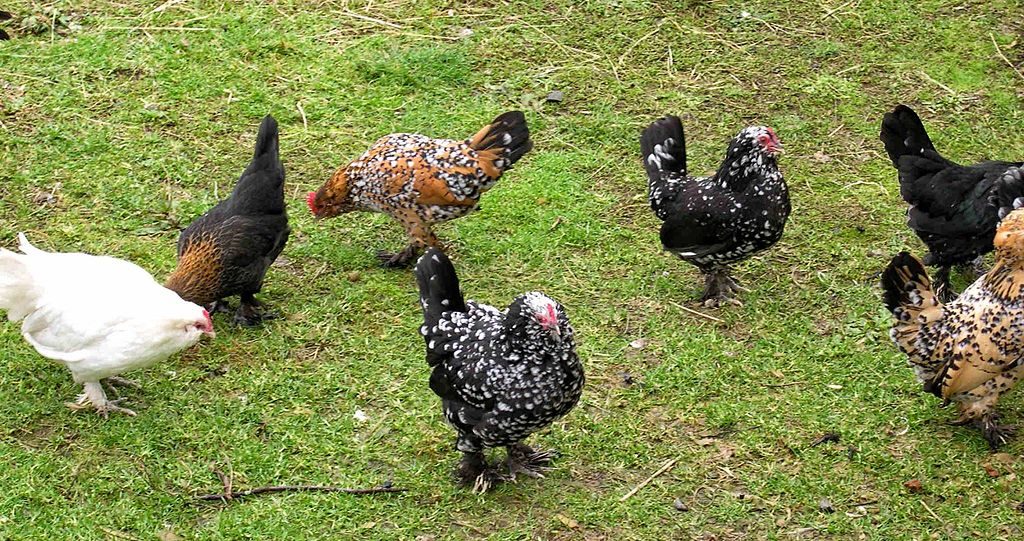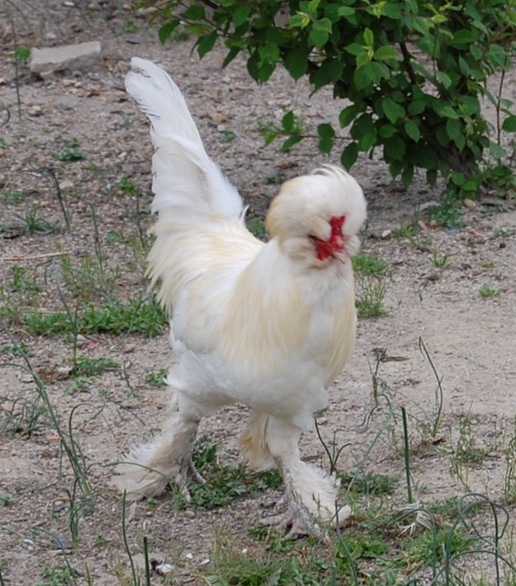Look anywhere online, and you’ll likely find a ton of articles and plenty of information about the “biggest chicken breed,” the “most productive chicken breed,” the “heaviest chicken breed,” and more.
All in all, most people want to raise big, beefy birds – even when they’re only raising them for a few eggs out of the backyard.
However, there are plenty of good reasons to raise small chickens, too.
The smallest chicken breeds are not only adorable, but they’re also easy to raise. They are more likely to be friendly, and they’re perfect for a small backyard.
So…do you have what it takes to raise one of the twelve smallest chicken breeds?
Let’s find out!
Why Would You Want a Small Chicken?
Here are a few reasons that you should look into owning a small chicken breed:
Less Food Consumption
If you raise a smaller chicken, it’s going to eat less. It’s as simple as that.
If you want to raise chickens in a free-range fashion without having them ravage your garden, raising a bantam chicken breed might be the way to go.
These birds are often half the size of standard breeds, meaning they’ll require a fraction of the feed, too.
To be fair, you might not be able to make a jumbo-sized omelet from a bantam egg – but most small chickens lay just as often as their larger counterparts.
While bantam eggs tend to be smaller, they are much cuter and can be used in a variety of ways.
Small Coop or Living Space
The smaller the chicken, the less it will require.
That goes for food, housing, and everything else.
They’ll also produce less waste! This means that small chicken breeds are often easier and less expensive to raise.
Plus, if you live in an area that has restrictions on the size of your chicken coop, you just may not be set up to raise monstrous birds like Jersey Giants.
These small chicken breeds allow you to keep chickens even if you have limited space to work with.
Great Personalities
Smaller chickens usually know that they don’t have a lot to offer in the way of fighting skills – therefore, they tend to be more docile.
If you have children or want a chicken that you can easily handle, consider raising one of these small chicken breeds.
What is a Bantam Chicken?
A bantam chicken is one that is a smaller counterpart of a large chicken breed.
In most cases, a bantam chicken will be about a half to a third of the size of its larger counterpart.
There are some chickens, however, that are considered “true” bantams.
A true bantam breed is one that has no other large counterpart. These breeds are breeds within themselves and do not have a full-sized alternative.
12 Small Chicken Breeds That We Recommend
Here are 12 of our favorite small chicken breeds:
1. Silkie

- Maximum Size: 2-3 lbs
- Temperament: Docile and easy to train
- Eggs: Up to 120 per year
- Meat: Considered a delicacy in Asia, but otherwise not raised for meat
The Silkie chicken should win an award for being the most popular small chicken breed!
It is so cute, fluffy, and adorable that it’s one of the most commonly chosen ornamental breeds in the United States.
While Silkies are often raised as full-sized breeds in other countries, they are only available in the United States in the bantam variety.
These chickens begin laying eggs at around 20 weeks of age, and are some of the best mothers you will find.
Easy to handle and with a predisposition to go broody, these chickens are commonly selected by backyard breeders who want their Silkies to sit on other eggs besides their own – something they often do even with eggs of other poultry species!
Silkie chickens look like little puff balls and come in a variety of colors.
They have blue earlobes and skin and bones that are entirely black, making them a highly sought after bird in some corners of the world.
2. Booted Bantam (Sablepoot)

- Maximum Size: Less than 2 lbs
- Temperament: Docile
- Eggs: 150-180 tiny white eggs each year
- Meat: Minimal
The Booted Bantam is one of the oldest and rarest Bantam breeds around – yet it’s also one of the true bantam breeds.
It has six-inch long feathers that cover its hocks and feet, which is why the bird is referred to as Sablepoot in Dutch.
Booted Bantams are quite small, with males rarely reaching two pounds. It has large wings with broad backs and has been a popular backyard species for years as it is quite a good pet.
Although Booted Bantams lay plenty of eggs, these aren’t usually suitable for eating because they are so small. However, they are exceptional mothers.
Booted Bantams can be susceptible to disease and fluctuations in climate, so they aren’t a great choice if you’re new to backyard chicken keeping.
However, if you are interested in exhibiting chickens or having a new pet, this is a good option for you to consider.
3. Sebright

- Maximum Size: Less than 2 lbs
- Temperament: Friendly but chatty
- Eggs: 160 per year
- Meat: Minimal
Another true Bantam – meaning it has no full-size counterpart – this chicken was bred and named by Sir John Saunders Sebright in the 1800s.
Designed to be an ornamental chicken breed, this rose-combed chicken is very low-maintenance and a good option for people who are new to raising ornamental breeds.
These chickens are not meat birds, and while they can be a bit noisy, they lay up to 160 small white eggs each year.
They start laying relatively early, at around 16 weeks, and produce magnificent plumage.
They’re a popular show bird and are great companions for young children.
4. Belgian d’Anvers

- Maximum Size: Less than 2 lbs
- Temperament: Occasionally aggressive
- Eggs: Up to 160 per year
- Meat: Minimal
The Belgian d’Anvers is often considered a Bantam because it has no other full-size counterpart.
These chickens lay a ton of tiny white eggs but are more commonly raised as ornamental birds.
Originally from Belgium, Belgian d’Anvers roosters can be quite dominant among the other members of the flock – yet love being around humans.
They are gentle and curious and get along well with children/
These chickens often do not have wattles, but instead have asymmetrical bodies that allow it to carry itself upright and proud.
These low-maintenance chickens can be raised for egg production or meat production, but since they put on so little weight, the latter is not necessarily advised.
These chickens, too, can be quite noisy! If you live in the city, you may want to avoid these chickens, as they can get loud when they are aggressive.
Otherwise, they are easy to handle and come in fourteen different colors, including splash, black, porcelain, mille fleur, quail, mottled, and more.
5. Cochin Bantams

- Maximum Size: Less than 2 lbs
- Temperament: Broody
- Eggs: Up to 160 per year
- Meat: Decent
These chickens originated in China and are great broody mothers.
If you are interested in hatching your own eggs, you should definitely consider this breed.
Also known as Pekin Bantams, Cochin bantams are primarily ornamental and come in a variety of colors, such as partridge, buff, golden laced, barred, white, black, mottled, and red.
Cochins are usually quite large birds, growing up to nine pounds at times, but the bantam variety of this breed is much smaller, rarely reaching two pounds.
These chickens require closed protected coops, as they do best with limited space and are prone to attacks from hawks and other airborne predators.
These birds can lay up to three or four eggs each week. They tend to go broody and make excellent mothers.
6. Belgian Bearded d’Uccle

- Maximum Size: Less than 2 pounds
- Temperament: Broody and good foragers
- Eggs: Up to 100 per year
- Meat: Poor quality
The name seems hard to pronounce, but the Belgian Bearded d’Uccle (pronounced dew-clay) is a small chicken breed you have to consider.
This chicken is often referred to as the Mille Fleur, which is simply the most color variant in which this chicken is found.
d’Uccle chickens have full beards and muffs along with a broad back and a stock neck. It has feathered feet and a prominent tail.
You can find this chicken in other color varieties as well, including silver quail, Lavender, white, and more, but only seven are actually recognized by the American Poultry Association.
These chickens are often confused with Booted Bantams, but they are quite different in that the Booted Bantams do not have beards or muffs.
These feather-legged beauties are small, only growing up to 22 ounces in most cases.
While they aren’t exceptional layers, only producing around 100 eggs per year, they do lay year-round and go broody quite easily.
7. Sultan Bantam

- Maximum Size: 1.5 lbs
- Temperament: Approachable and loving
- Eggs: Less than 60 per year
- Meat: Poor quality
The Sultan Bantam is one of America’s favorite ornamental chicken breeds.
With origins dating all the way back to the Ottoman empire, these chickens have a unique style of feathering that covers their entire heads all the way down to their feet.
They are usually white and their feathers are poofy. Interestingly, they have five toes instead of the standard four!
What’s truly unique about these chickens is that it’s not only their heads that are white – but their beaks are white, too!
These chickens have pinkish-red combs and make excellent show birds due to their calm, relaxed demeanor.
These chickens are not spectacular layers, only producing about one tiny egg each week.
They are also not known to be broody. However, they make great pets and will easily come up to you for a quick cuddle.
8. Japanese Bantam
- Maximum Size: Less than 2 lbs
- Temperament: Shy
- Eggs: Fewer than 60 per year
- Meat: Minimal
Japanese Bantams are quite interesting to look at, as it always appears as though they are squatting.
These chickens have exceptionally short legs and are a true Bantam breed.
They have no feathers on their legs but instead have gorgeous, fanning tails that spread out on a rooster and stand up straight on a hen.
There are several color variations of this breed, but one of the most common is the Black Tailed White Japanese Bantam.
This chicken has a white body and feathers that eventually lead to a waterfall of elegant black feathers.
These birds have a reputation for being a bit timid, but they are also very easy to tame.
They don’t lay a lot of eggs – usually only about one per week – but these will be cream or tinted in color. They also make excellent mothers.
9. Dutch Bantams
- Maximum Size: Less than 20 ounces
- Temperament: Nervous
- Eggs: About 100 per year
- Meat: Poor quality
Dutch Bantams have a reputation for being nervous chickens, but they’re quite friendly.
However, you have to be careful when interacting with them, as they will startle at the slightest noise.
These chickens are true-bantams – there is no standard-size version of the breed, but they come in multiple varieties such as Golden Duckwing, Blue Golden, Cuckoo, and Partridge.
These chickens are good setters and also are excellent, protective mothers.
They are decent layers, typically producing about two light-brown bantam eggs per week.
These chickens have a single comb and while they aren’t especially cold or heat hardy, they do well in confinement.
10. Buff Brahma Bantams
- Maximum Size: Less than 3 lbs
- Temperament: Friendly and active
- Eggs: Minimal
- Meat: Minimal
These chickens are a miniature version of the popular Brahma breed.
Recognized by the American Poultry Association in 1946, Buff Brahma Bantams are child-friendly chicken breeds that are also commonly raised for exhibition.
They have feathered feet and are a buff-colored with a black ridge around the neck, tail, and wing tips.
These chickens are quite hardy and can bear both hot and cold conditions well.
They lay few eggs, and while they aren’t designed for meat production, they make a great breed to be raised as a family pet.
11. Rosecomb Bantams
- Maximum Size: Less than 2 lbs
- Temperament: Nervous
- Eggs: 50 per year
- Meat: Minimal
Rosecomb Bantams are self-sufficient chickens who don’t let their size get them down!
These friendly chickens are easy to approach and come in a variety of colors.
These chickens can be a bit feisty, but they are gorgeous ornamental chickens nonetheless.
These chickens are true bantams with no larger counterparts. First accepted by the American Poultry Association in 1874, this breed is not ideal for novice chicken keepers.
This is because Rosecomb Bantams have a tendency to be a bit flighty and temperamental.
They aren’t great egg layers, producing only about 50 cream-colored eggs each year. They also are not designed to be meat birds.
12. Serama Bantams
- Maximum Size: 19 ounces
- Temperament: Friendly and quiet
- Eggs: Up to 160 per year
- Meat: Poor quality
Serama Bantams are often referred to as the smallest chickens in the world.
Native to Malaysia, these chickens stand erect and upright with their heads practically touching their tail feathers.
Though they can be found in multiple different color variants, the only one recognized by the American Poultry Association is white.
These chickens are calm and friendly, and even the roosters aren’t that loud. They are easy to handle and train and overall are very docile.
Although the eggs that the hens produce aren’t that large, they lay lots of them – up to four per week!
How to Care for Small Chicken Breeds
Raising a small or bantam breed of chicken is no different than if you were raising another type of chicken.
However, there are some considerations you will need to make regarding their size in order to successfully raise small chickens.
Be Careful During Incubation
Some bantam breeds are extremely difficult – if not impossible – to hatch on your own.
While smaller chicken breeds are more likely to go broody on their own, it can be tough to hatch eggs in an incubator because many of them have a tendency to hatch early – as much as three days, in fact.
Therefore, if you are hatching your own eggs in an incubator, you will need to make a point of removing the turner earlier than normal so that the eggs can get into a teaching position.
Keep an Eye on the Weather
Bantam chickens need about a third of the coop and run space as full-sized breeds – but remember, the more space will never hurt.
You should make sure your chickens have ample protection against the weather, however.
Depending on the breed, most small chickens are quite susceptible to extreme temperature fluctuations.
Some small chicken breeds, like the Silkie, need additional protection from the weather.
They can’t get wet because their feet are feathered and their bodies are so small that it makes it difficult for them to stay warm.
The small Serema chicken, too, needs extra protection during the cold.
That being said, it’s all up to the breed and disposition of your individual chickens. Some bantams do quite well in extreme temperatures – Cochin bantams, for instance, are extremely cold tolerant.
Make Sure Your Birds Are Protected Against Predators
It can be tough for small chickens to get away from predators.
If you are raising one of the small chicken breeds we mentioned that has a tendency to become flighty, that’s great – that flightiness will give your birds some added protection against predators.
However, keep in mind that since these chickens often have smaller legs and smaller wings, they will have a harder time getting away.
Make sure you have ample protection for your chickens, whether that be in the form of a tall fence, a covered run, or even just a super-aggressive bantam rooster, to make sure they stay safe.
That advice goes for other chickens, too.
It’s a good idea to keep your bantam flock separate from your full-size chickens, especially if you have large breeds in your backyard.
Full-sized roosters can often injure or kill bantam hens by mistake while attempting to mate.
Larger chickens also have a tendency to be aggressive in the pecking order. Plus, if the larger chickens reject a single bantam, your bird will have a hard time staying warm.
There you have it! These twelve chicken breeds are not only pint-sized, but they’re also adorable and a lot of fun to raise.
If you’re thinking of adding a bantam chicken breed to your backyard flock, whether it’s for exhibition or just to have as a pet, consider these breeds (and our advice!) to keep them happy and healthy.
